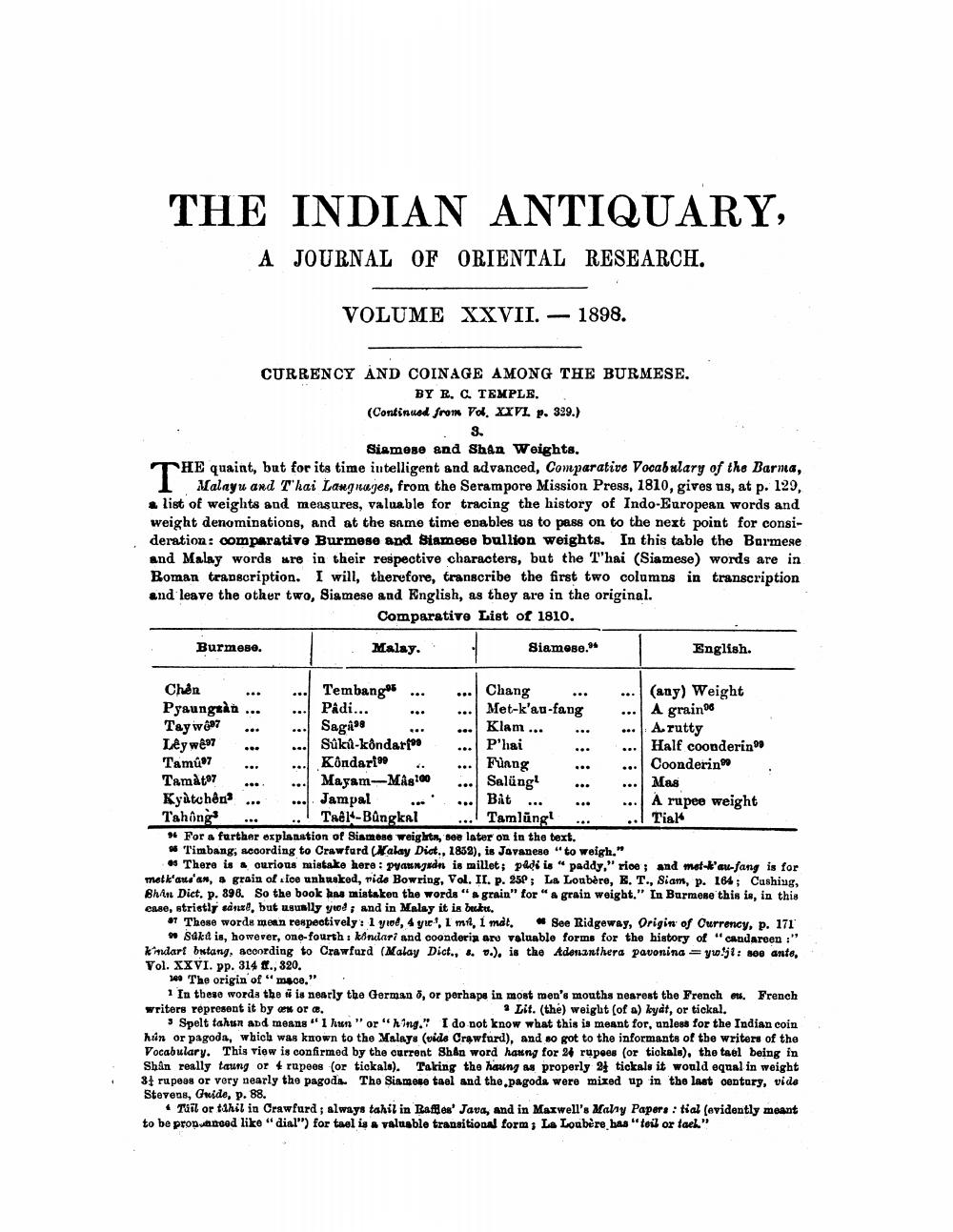Book Title: Indian Antiquary Vol 27 Author(s): Richard Carnac Temple Publisher: Swati Publications View full book textPage 5
________________ THE INDIAN ANTIQUARY, A JOURNAL OF ORIENTAL RESEARCH. VOLUME XXVII. — 1898. CURRENCY AND COINAGE AMONG THE BURMESE. BY R. C TEMPLE. (Continued from Vol. XXVI. p. 329.) Siamese and Shan Weights. THE quaint, but for its time intelligent and advanced, Comparative Vocabulary of the Barna, 1 Malayu and Thai Langnajes, from the Serampore Mission Press, 1810, gives us, at p. 129, . list of weights and measures, valuable for tracing the history of Indo-European words and weight denominations, and at the same time enables us to pass on to the next point for consideration: comparative Burmese and Siamese bullion weights. In this table the Barmere and Malay words are in their respective characters, but the Thai (Siamese) words are in Boman transcription. I will, therefore, transcribe the first two columns in transcription and leave the other two, Siamese and English, as they are in the original. Comparative List of 1810. Burmese. Malay. Siamese. English. Chang Klam... Chên Tembang ... (any) Weight Pyaungtan ... Padi... Met-k'ao-fang A grainos Тау w97 Sagi98 A rutty Ley wê97 Súku-kondart P'hai Half coonderin Tamu 7 Kondari89 Fuang Coonderin Tamåte7 ... Mayam--MAS? Salung! Mas Kyàtchen ... ... Jampal ... ... Bit ... A rupee weight Tahông ... ..! Tall-Bungkal ... Tamlung! .. Tial # For a further explanation of Siamese weights, see later on in the text. # Timbang, according to Crawford (Kalay Dict., 1852), is Javanese "to weigh." • There is a ourious mistake here : pvaungan is millet; padi is " paddy." rice; and mot-kau-fang is for matk'ani'an, a grain of Ice unhusked, ride Bowring, Vol. II. p. 258; La Loubère, E.T., Siam, p. 164; Cushing, Bhan Dict. p. 898. So the book kne mistaken the words " grain" for "&grain weight." In Burmese this is, in this ease, strictly sdned, but usually yłod; and in Malay it is buku. T Those words menn respectively: 1 yiod, 4 y , 1 m, 1 mal. "See Ridgeway, Origin of Currency, p. 171 Sakd is, however, one-fourth: kondari and coonderin aru valuable forms for the history of "Candaroon." k art butang, acording to Crawfurd (Malay Dict., 4. v.), is the Adonanthera pavonina = y.jt: non ante, Vol. XXVI. pp. 314 &., 820. 18 The origin of "mece." . 1 In these words the ñ is nearly the German 8, or perhaps in most men's mouths nearest the French eu. French writers represent it by ex ore. Lit. (the) weight (of a) kyat, or tickal. 3 Spelt tahun and means "1 lun" or "ning. I do not know what this is meant for, unless for the Indian coin hún or pagoda, which was known to the Malays (vids Crawford), and so got to the informants of the writers of the Vocabulary. This view is confirmed by the current Shân word haung for 24 rupees (or tickals), the tael being in Shan really taung or 4 rupees (or tiokala). Taking the haung as properly 24 tickals it would equal in weight 34 rupees or very nearly the pagode. The Siamese taal and the.pagoda were mixed up in the last century, vide Stevens, Gwide, p. 88. Túil or tlhil in Crawfurd; always tahil in Raffles' Java, and in Maxwell's Many Papers : tial (evidently meant to be pronanead like "dial") for taol is a valuable transitional form: La Loabere has "tsil or taeh."Page Navigation
1 ... 3 4 5 6 7 8 9 10 11 12 13 14 15 16 17 18 19 20 21 22 23 24 25 26 27 28 29 30 31 32 33 34 35 36 37 38 39 40 41 42 43 44 45 46 47 48 49 50 51 52 ... 404
